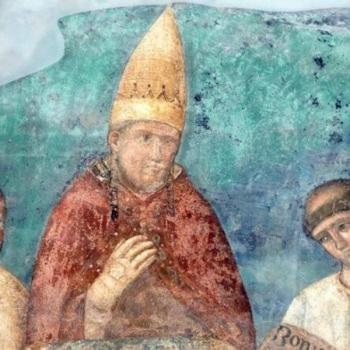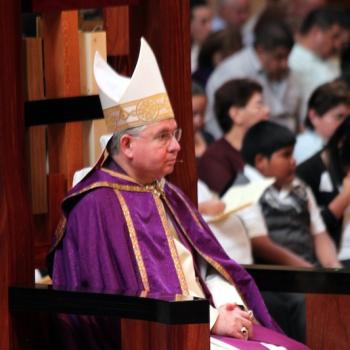 Had I wanted to be more precise and accurate in the title of this blog, I should have written Basilica of the Savior and Saints John the Baptist and Evangelist at the Lateran. This is the full name of this basilica which, as two inscriptions reveal on its facade, is the mother church of Rome and the whole world.
Had I wanted to be more precise and accurate in the title of this blog, I should have written Basilica of the Savior and Saints John the Baptist and Evangelist at the Lateran. This is the full name of this basilica which, as two inscriptions reveal on its facade, is the mother church of Rome and the whole world.
What follows is the translation of a presentation I did for a class I took in seminary where we studied the transformation of Rome from a pagan to a Christian city. The presentation included this text, ancient maps and archeological sketches.
In Republican times, before the time of Christ, the area of Rome where the present-day Lateran Basilica stands was outside the walls of the city. It was an agricultural area with several tombs along the road that led into the city.
In the first century after Christ, the area was urbanized with well-built houses and stores. Remains of stores have been found beneath the hospital which stands immediately behind the present-day basilica. Among the houses in the area was the house of Domizia Lucilla, the mother of the emperor Marcus Aurelius. An aqueduct was built through the area, delivering water to the city (traces of it can be seen today). The house built immediately on the location where the basilica stands today belonged to the Laterano family. The property was confiscated in 65 AD by Emperor Nero after he condemned Plauzio Laterano a traitor and decapitated him. The land became imperial property.
In the second century, Septimus Severus destroyed the Lateran house to build new barracks for the imperial guard, the Equites Singulares. The complex became extensive including a praetorium, lodging, a portico and a bathhouse. Remains of the foundations of this complex were found in 1934 by Enrico Josti underneath the nave and cloister of the basilica. An inscription from 197 AD dedicating the barracks was discovered that read: For the health of Septimus Severus and his sons Caracalla and Geta.
Septimus Severus also built beautiful houses on this imperial property for military favorites, among them Tito Sextio Laterano. His house, built in the 2nd century, become known as the Domus Laterani, the Lateran house. The house still stood in the 4th century and had given the area the name Laterano.
When Emperor Constantine defeated the imperial-contender Maxentius at the Battle of the Milvian Bridge in 312 AD, he desired to punish the Equites Singulares because they had remained faithful to Maxentius. Constantine razed their headquarters leaving only 30cm of wall above the ground. These remains served as part of the foundation for Constantine’s new construction project: a public building for the Bishop of Rome.
When Constantine took possession of Rome, the city was controlled by those still faithful to the Roman gods. His desire to build the first public place where the Bishop of Rome could hold audiences and celebrate the Eucharist had to be well planned. To avoid conflict with the Senate he built the basilica away from the center of public life. He chose the Lateran neighborhood in the outskirts of the city.
Construction took four to five years and the basilica was dedicated on November 9, 318. The Liber Pontificalis, the official history of the Church, records that Pope Sylvester and Emperor Constantine dedicated the basilica. Since Constantine wished to provide a public building for the Bishop of Rome, the architecture chosen for the building was a basilica. Roman basilicas were large public areas where courts met and trade occurred. The forum of Rome and all major Roman cities had at least one basilica where business could be conducted. Ruins of several basilicas can be viewed in the Roman forum, the best preserved and most impressive being the basilica of Maxentius seen in the picture below (the three large arches made up the right-hand nave of the basilica).

The original Lateran basilica was a large hall with five naves divided by columns with a semi-circular apse and a small transept. The columns were made of yellow and green marble.
Nothing from this original basilica is visible today, only the original dimensions have been preserved. The original basilica stood until the 17th century when Borromini remodeled it completely.
 At first the basilica was named Basilica of the Savior, but Pope Gregory the Great in the 6th century changed the name by adding Saints John the Baptist and John the Evangelist.
At first the basilica was named Basilica of the Savior, but Pope Gregory the Great in the 6th century changed the name by adding Saints John the Baptist and John the Evangelist.
Until the 14th century, the Lateran Basilica served as the Apostolic Palace where the Pope resided. In the early 14th century the Popes moved to Avignon in France and when they returned decades later, they moved to the Vatican Hill where they have remained until modern times. The only two things that remain from the medieval Apostolic Palace are the Sancta Sanctorum, a small chapel on the second floor of the building that houses the Holy Stairs, and the open-air apse mosaics of Leo III.
The basilica is the cathedral of Rome, the church of the Bishop of Rome, the Pope. Therefore this church with all its history and tradition is indeed the mother church of Rome and the world. Of Rome because it’s the cathedral of the city, and of the world since the Bishop of Rome is the Supreme Pontiff, the visible head of the Church on earth.
Bibliography
Holloway, Ross. Constantine and Rome. London: Yale University Press, 2004.
Ilari, Annibale. Constantiniana Arcibasilica in Laterano: Guida Storico-Bibliografica. Roma: Laterano, 2000.
Krautheimer, Richard, Spencer Corbett e Alfred Frazer. Corpus Basilicarum Christianorum Romae Vol 5. Citta del Vaticano, 1977.
Pietrangeli, Carlo, ed. San Giovanni in Laterano. Firenze: Nardini Editore, 1990.
de Rosa, Elio, ed. Roma Sacra: San Giovanni in Laterano. Roma: Cosofilm, 2000.
All pictures are mine, all rights reserved













